Identifying Sustainable Offshore Wind Farm Sites in Greece Under Climate Change
Abstract
1. Introduction
2. Materials and Methods
2.1. OWF Site Selection Framework
2.2. Study Area (Step 1)
2.3. Data Collection (Step 2)
2.4. Exclusion of Unsuitable Areas for OWF Site Selection (Step 3)
Exclusion Criteria
ExC1: Water Depth
ExC2: Annual Average Wind Velocity
ExC3: Environmentally Protected Areas (EPAs)-Natura 2000
ExC4: EPAs—Areas of Outstanding Natural Beauty (AONBs)
ExC5: EPAs—Important Areas for Birds (IBAs)
ExC6: EPAs—Seagrass Meadows
ExC7: Areas of Cultural Heritage (CHAs)-Underwater Antiquities
ExC8: CHAs—Monuments
ExC9: CHAs—Archeological and Historical Sites
ExC10: CHAs—Traditional Settlements
ExC11: Human Settlements
ExC12: Bathing Coasts
ExC13: Areas of Military Exercise
ExC14: Marine Routes
ExC15: Fisheries Areas
ExC16: Areas of Aquaculture
ExC17: Airports
ExC18: Underwater Cables (UC)—Telecommunication
ExC19: UC–Energy
2.5. Determination of Evaluation Criteria (Step 4)
Evaluation Criteria
EvC1: Water Depth
EvC2: Annual Average Wind Velocity
EvC3: Environmentally Protected Areas (EPAs)–Natura 2000
EvC4: EPAs—Areas of Outstanding Natural Beauty (AONBs)
EvC5: EPAs—Important Areas for Birds (IBAs)
EvC6: EPAs—Seagrass Meadows
EvC7: Marine Routes
EvC8: Airports
EvC9: Ports
EvC10: UC–Energy
2.6. Weighting the Evaluation Criteria (Step 5)
2.6.1. The Analytic Hierarchy Process (AHP)
2.6.2. Expert Judgment
2.7. Final Suitability Map for OWF Site Selection (Step 5)
Final Scores (FS) of Each Spatial Unit
3. Results and Discussion
3.1. Exclusion of Unsuitable Marine Areas
3.2. Evaluation of Suitable Marine Areas
3.2.1. Evaluation Criteria
3.2.2. AHP Weights
3.3. Final Suitability Map
4. Conclusions
Supplementary Materials
Author Contributions
Funding
Data Availability Statement
Acknowledgments
Conflicts of Interest
References
- European Commission. Communication on the 2030 Climate Target Plan: Stepping Up Europe’s 2030 Climate Ambition. In Investing in a Climate-Neutral Future for the Benefit of Our People COM/2020/562 Final; European Commission: Brussels, Belgium, 2020. [Google Scholar]
- Martinez, A.; Iglesias, G. Evaluation of offshore wind energy zones within marine spatial planning: A case study in the Spanish Mediterranean Sea. Energy Rep. 2024, 11, 3461–3473. [Google Scholar] [CrossRef]
- van Sluis, C.J.; van Onselen, E.; Airoldi, L.; Duarte, C.M.; van Rijswick, H.F.M.W.; van der Heide, T.; Olie, R.A.; Kelder, M.; Bouma, T.J. Financing marine restoration through offshore wind investments. BioScience 2025, biaf092. [Google Scholar] [CrossRef]
- Duarte, C.M.; Agusti, S.; Barbier, E.; Britten, G.L.; Castilla, J.C.; Gattuso, J.-P.; Fulweiler, R.W.; Hughes, T.P.; Knowlton, N.; Lovelock, C.E.; et al. Rebuilding marine life. Nature 2020, 580, 39–51. [Google Scholar] [CrossRef]
- Wind Europe. Wind Energy in Europe: 2024 Statistics and the Outlook for 2025–2030; Wind Europe: Brussels, Belgium, 2024. [Google Scholar]
- European Commission. An EU Strategy to Harness the Potential of Offshore Renewable Energy for a Climate Neutral Future COM(2020) 741 Final; European Commission: Brussels, Belgium, 2020. [Google Scholar]
- Durakovic, G.; del Granado, P.C.; Tomasgard, A. Powering Europe with North Sea offshore wind: The impact of hydrogen investments on grid infrastructure and power prices. Energy 2023, 263, 125654. [Google Scholar] [CrossRef]
- Martinez, A.; Iglesias, G. Climate-change impacts on offshore wind resources in the Mediterranean Sea. Energy Convers. Manag. 2023, 291, 117231. [Google Scholar] [CrossRef]
- Wawrzynkowski, P.; Molins, C.; Lloret, J. Assessing the potential impacts of floating Offshore Wind Farms on policy-relevant species: A case study in the Gulf of Roses, NW Mediterranean. Mar. Policy 2025, 172, 106518. [Google Scholar] [CrossRef]
- Lloret, J.; Turiel, A.; Solé, J.; Berdalet, E.; Sabatés, A.; Olivares, A.; Gili, J.-M.; Vila-Subirós, J.; Sardá, R. Unravelling the ecological impacts of large-scale offshore wind farms in the Mediterranean Sea. Sci. Total Environ. 2022, 824, 153803. [Google Scholar] [CrossRef] [PubMed]
- Umoh, K.; Hasan, A.; Kenjegaliev, A. Combined AHP-GIS methodology for floating offshore wind site selection in South Africa. Ocean. Eng. 2025, 317, 120037. [Google Scholar] [CrossRef]
- Caceoğlu, E.; Yildiz, H.K.; Oğuz, E.; Huvaj, N.; Guerrero, J.M. Offshore wind power plant site selection using Analytical Hierarchy Process for Northwest Turkey. Ocean. Eng. 2022, 252, 111178. [Google Scholar] [CrossRef]
- Vinhoza, A.; Schaeffer, R. Brazil’s offshore wind energy potential assessment based on a Spatial Multi-Criteria Decision Analysis. Renew. Sustain. Energy Rev. 2021, 146, 111185. [Google Scholar] [CrossRef]
- Gkeka-Serpetsidaki, P.; Skiniti, G.; Tournaki, S.; Tsoutsos, T. A Review of the Sustainable Siting of Offshore Wind Farms. Sustainability 2024, 16, 6036. [Google Scholar] [CrossRef]
- Spyridonidou, S.; Vagiona, D.G.; Loukogeorgaki, E. Strategic Planning of Offshore Wind Farms in Greece. Sustainability 2020, 12, 905. [Google Scholar] [CrossRef]
- Tsarknias, N.; Gkeka-Serpetsidaki, P.; Tsoutsos, T. Exploring the sustainable siting of floating wind farms in the Cretan coastline. Sustain. Energy Technol. Assess. 2022, 54, 102841. [Google Scholar] [CrossRef]
- Gkeka-Serpetsidaki, P.; Tsoutsos, T. A methodological framework for optimal siting of offshore wind farms: A case study on the island of Crete. Energy 2022, 239, 122296. [Google Scholar] [CrossRef]
- Gazos, K.; Vagiona, D.G. Marine Suitability Assessment for Offshore Wind Farms’ Deployment in Thrace, Greece. Sustainability 2024, 16, 4204. [Google Scholar] [CrossRef]
- Stefanakou, A.A.; Nikitakos, N.; Lilas, T.; Pavlogeorgatos, G. A GIS-based decision support model for offshore floating wind turbine installation. Int. J. Sustain. Energy 2019, 38, 673–691. [Google Scholar] [CrossRef]
- Vagiona, D.; Karanikolas, N. A multicriteria approach to evaluate offshore wind farms siting in Greece. Glob. Nest J. 2012, 14, 235–243. [Google Scholar]
- Vagiona, D.G.; Kamilakis, M. Sustainable Site Selection for Offshore Wind Farms in the South Aegean—Greece. Sustainability 2018, 10, 749. [Google Scholar] [CrossRef]
- Vasileiou, M.; Loukogeorgaki, E.; Vagiona, D.G. GIS-based multi-criteria decision analysis for site selection of hybrid offshore wind and wave energy systems in Greece. Renew. Sustain. Energy Rev. 2017, 73, 745–757. [Google Scholar] [CrossRef]
- Susini, S.; Menéndez, M.; Eguía, P.; Blanco, J. Climate Change Impact on the Offshore Wind Energy Over the North Sea and the Irish Sea. Front. Energy Res. 2022, 10, 881146. [Google Scholar] [CrossRef]
- Pryor, S.; Barthelmie, R.; Kjellström, E. Analyses of the potential climate change impact on wind energy resources in northern Europe using output from a Regional Climate Model. Clim. Dyn. 2005, 25, 815–835. [Google Scholar] [CrossRef]
- Chalastani, V.I.; Tsoukala, V.K.; Coccossis, H.; Duarte, C.M. A bibliometric assessment of progress in marine spatial planning. Mar. Policy 2021, 127, 104329. [Google Scholar] [CrossRef]
- Melissas, D.; Asprogerakas, E. Spatial parameters for the development of floating wind farms in Greece. Eur. J. Geogr. 2022, 13, 001–017. [Google Scholar] [CrossRef]
- Olsen, E.; Fluharty, D.; Hoel, A.H.; Hostens, K.; Maes, F.; Pecceu, E. Integration at the Round Table: Marine Spatial Planning in Multi-Stakeholder Settings. PLoS ONE 2014, 9, e109964. [Google Scholar] [CrossRef] [PubMed]
- Soukissian, T.; Hatzinaki, M.; Gerasimos, K.; Papadopoulos, A.; Kallos, G.; Anadranistakis, M. Wind and Wave Atlas of the Hellenic Seas; Hcmr publication: Anavyssos, Greece, 2007. [Google Scholar]
- Soukissian, T.; Prospathopoulos, A.; Hatzinaki, M.; Kabouridou, M. Assessment of the Wind and Wave Climate of the Hellenic Seas Using 10Year Hindcast Results. Open Ocean Eng. J. 2008, 1, 1–12. [Google Scholar] [CrossRef][Green Version]
- BVG Associates. Unleashing Europe’s Offshore Wind Potential: A New Resource Assessment; BVG Associates: Brussels, Belgium, 2017. [Google Scholar]
- Greek Ministry of Environment and Energy. Available online: https://ypen.gov.gr/gia-proti-fora-sti-chora-thalassios-chorotaxikos-schediasmos/ (accessed on 20 June 2025).
- Tsiara, C.; Katsardi, V.; Spiliotopoulos, G.; Vasiliades, L. Optimal and Sustainable Siting of Offshore Wind Farms in Greece: Environmental Considerations, Cost Analysis, and Comparative Evaluation of State-Proposed Development Areas. Available online: https://papers.ssrn.com/sol3/papers.cfm?abstract_id=5355173 (accessed on 30 July 2025).
- European Commission. 89/EU Directive of the European Parliament and of the Council of 23 July 2014 Establishing a Framework for Maritime Spatial Planning; European Commission: Brussels, Belgium, 2014. [Google Scholar]
- EMODnet. Yourgateway to Marine Data in Europe. Available online: https://emodnet.ec.europa.eu/en (accessed on 15 March 2025).
- THAL-CHOR 2 Geoportal. Available online: https://thalchor-2.ypen.gov.gr (accessed on 15 March 2025).
- Independent Power Transmission Operator (IPTO). Available online: https://www.admie.gr/systima/perigrafi/hartis-grammon (accessed on 15 March 2025).
- GEODATA: Digital data. Available online: http://geodata.gov.gr/ (accessed on 15 March 2025).
- Hellenic Ornithological Society. Available online: https://ornithologiki.gr/en/ (accessed on 15 March 2025).
- Filotis Database. Available online: https://filotis.itia.ntua.gr/info_usage/ (accessed on 15 March 2025).
- Topouzelis, K. Supplementary Files of Paper Titled “Seagrass Mapping in Greek Territorial Waters Using Landat-8 Satellite Images”. 2017. Available online: https://zenodo.org/records/1120338 (accessed on 3 August 2025).
- European Atlas of the Sea. Available online: https://ec.europa.eu/maritimeaffairs/atlas/maritime_atlas/#lang=EN;p=w;bkgd=5;theme=78:1;c=950564.0893519891,6935472.822042013;z=6 (accessed on 15 March 2025).
- Copernicus Climate Change Service (C3S). Copernicus Climate Data Store. Available online: https://cds.climate.copernicus.eu (accessed on 10 February 2025).
- National Aeronautics and Space Administration (NASA). IPCC AR6 Sea Level Projection Tool; NASA Sea Level Change Portal; National Aeronautics and Space Administration (NASA): Washington, DC, USA, 2021.
- Intergovernmental Panel on Climate Change. Climate Change 2023: Synthesis Report. Contribution of Working Groups I, II and III to the Sixth Assessment Report of the Intergovernmental Panel on Climate Change; Intergovernmental Panel on Climate Change: Geneva, Switzerland, 2023; pp. 35–115. [Google Scholar]
- Shi, J.; Hu, M.; Zhang, Y.; Chen, X.; Yang, S.; Hallak, T.S.; Chen, M. Dynamic Analysis of Crane Vessel and Floating Wind Turbine during Temporary Berthing for Offshore On-Site Maintenance Operations. J. Mar. Sci. Eng. 2024, 12, 1393. [Google Scholar] [CrossRef]
- Roh, C.; Ha, Y.-J.; Ahn, H.-J.; Kim, K.-H. A Comparative Analysis of the Characteristics of Platform Motion of a Floating Offshore Wind Turbine Based on Pitch Controllers. Energies 2022, 15, 716. [Google Scholar] [CrossRef]
- Pulselli, R.M.; Maccanti, M.; Bruno, M.; Sabbetta, A.; Neri, E.; Patrizi, N.; Bastianoni, S. Benchmarking Marine Energy Technologies Through LCA: Offshore Floating Wind Farms in the Mediterranean. Front. Energy Res. 2022, 10, 902021. [Google Scholar] [CrossRef]
- IEC 61400-1:2019; Wind Energy Generation Systems—Part 1: Design Requirements. International Electrotechnical Commission: Geneva, Switzerland, 2019.
- Schallenberg-Rodríguez, J.; García Montesdeoca, N. Spatial planning to estimate the offshore wind energy potential in coastal regions and islands. Practical case: The Canary Islands. Energy 2018, 143, 91–103. [Google Scholar] [CrossRef]
- Soares, P.M.M.; Lima, D.C.A.; Nogueira, M. Global offshore wind energy resources using the new ERA-5 reanalysis. Environ. Res. Lett. 2020, 15, 1040a2. [Google Scholar] [CrossRef]
- Tercan, E.; Tapkın, S.; Latinopoulos, D.; Dereli, M.A.; Tsiropoulos, A.; Ak, M.F. A GIS-based multi-criteria model for offshore wind energy power plants site selection in both sides of the Aegean Sea. Environ. Monit. Assess. 2020, 192, 652. [Google Scholar] [CrossRef] [PubMed]
- Marchowski, D.; Ławicki, Ł.; Kaliciuk, J. Management of Marine Natura 2000 Sites as Exemplified by Seabirds Wintering in the Baltic Sea: The Case of Poland. Diversity 2022, 14, 1081. [Google Scholar] [CrossRef]
- Martín, B.; Onrubia, A.; González-Arias, J.; Vicente-Vírseda, J.A. Citizen science for predicting spatio-temporal patterns in seabird abundance during migration. PLoS ONE 2020, 15, e0236631. [Google Scholar] [CrossRef]
- European Commission. Council Directive 92/43/EEC of 21 May 1992 on the Conservation of Natural Habitats and of Wild Fauna and Flora; Official Journal L 206; European Commission: Brussels, Belgium, 1992; pp. 7–50. [Google Scholar]
- Schoukens, H.; Cliquet, A. Biodiversity offsetting and restoration under the European Union Habitats Directive: Balancing between no net loss and deathbed conservation? Ecol. Soc. 2016, 21, 10. [Google Scholar] [CrossRef]
- Goodale, M.W.; Milman, A. Assessing Cumulative Exposure of Northern Gannets to Offshore Wind Farms. Wildl. Soc. Bull. 2020, 44, 252–259. [Google Scholar] [CrossRef]
- Stenhouse, I.J.; Berlin, A.M.; Gilbert, A.T.; Goodale, M.W.; Gray, C.E.; Montevecchi, W.A.; Savoy, L.; Spiegel, C.S. Assessing the exposure of three diving bird species to offshore wind areas on the U.S. Atlantic Outer Continental Shelf using satellite telemetry. Divers. Distrib. 2020, 26, 1703–1714. [Google Scholar] [CrossRef]
- United Nations. Enlargement of the Marine Protected Areas’ Network of Greece to Meet 30 % Target; UN SDG Partnerships Platform: New York, NY, USA, 2023. [Google Scholar]
- Smith, H. Greece Becomes First European Country to Ban Bottom Trawling in Marine Parks. Available online: https://www.theguardian.com/environment/2024/apr/16/greece-becomes-first-european-country-to-ban-bottom-trawling-in-marine-parks (accessed on 5 June 2025).
- Birdlife International. Available online: https://datazone.birdlife.org/country/factsheet/greece (accessed on 20 March 2025).
- Spiliopoulou, K.; Dimitrakopoulos, P.G.; Brooks, T.M.; Kelaidi, G.; Paragamian, K.; Kati, V.; Oikonomou, A.; Vavylis, D.; Trigas, P.; Lymberakis, P.; et al. The Natura 2000 network and the ranges of threatened species in Greece. Biodivers. Conserv. 2021, 30, 945–961. [Google Scholar] [CrossRef]
- Vanermen, N.; Onkelinx, T.; Verschelde, P.; Courtens, W.; Van de Walle, M.; Verstraete, H.; Stienen, E.W.M. Assessing seabird displacement at offshore wind farms: Power ranges of a monitoring and data handling protocol. Hydrobiologia 2015, 756, 155–167. [Google Scholar] [CrossRef]
- Hong, L.; Möller, B. Offshore wind energy potential in China: Under technical, spatial and economic constraints. Energy 2011, 36, 4482–4491. [Google Scholar] [CrossRef]
- Hemminga, M.A.; Duarte, C.M. Seagrass Ecology; Cambridge University Press: Cambridge, UK, 2000. [Google Scholar]
- The UNEP/MAP-SPA/RAC. Greece: Conservation of Mediterranean Marine and Coastal Biodiversity by 2030 and Beyond; The UNEP/MAP-SPA/RAC: Tunis, Tunisia, 2021; p. 105. [Google Scholar]
- Telesca, L.; Belluscio, A.; Criscoli, A.; Ardizzone, G.; Apostolaki, E.T.; Fraschetti, S.; Gristina, M.; Knittweis, L.; Martin, C.S.; Pergent, G.; et al. Seagrass meadows (Posidonia oceanica) distribution and trajectories of change. Sci. Rep. 2015, 5, 12505. [Google Scholar] [CrossRef]
- Marbà, N.; Díaz-Almela, E.; Duarte, C.M. Mediterranean seagrass (Posidonia oceanica) loss between 1842 and 2009. Biol. Conserv. 2014, 176, 183–190. [Google Scholar] [CrossRef]
- Castro-Santos, L.; deCastro, M.; Costoya, X.; Filgueira-Vizoso, A.; Lamas-Galdo, I.; Ribeiro, A.; Dias, J.M.; Gómez-Gesteira, M. Economic Feasibility of Floating Offshore Wind Farms Considering Near Future Wind Resources: Case Study of Iberian Coast and Bay of Biscay. Int. J. Environ. Res. Public Health 2021, 18, 2553. [Google Scholar] [CrossRef] [PubMed]
- Min, X.; Yi, Z.; Xiao-Jing, S.; Yun-Ling, Z.; Hai-Peng, Z. The distribution of large floating seagrass (Zostera marina) aggregations in northern temperate zones of Bohai Bay in the Bohai Sea, China. PLoS ONE 2019, 14, e0201574. [Google Scholar] [CrossRef] [PubMed]
- Díaz, H.; Fonseca, R.; Guedes Soares, C. Site selection process for floating offshore wind farms in Madeira Islands. In Advances in Renewable Energies Offshore; CRC Press: London, UK, 2018; pp. 729–737. [Google Scholar]
- Díaz, H.; Guedes Soares, C. An integrated GIS approach for site selection of floating offshore wind farms in the Atlantic continental European coastline. Renew. Sustain. Energy Rev. 2020, 134, 110328. [Google Scholar] [CrossRef]
- Liao, V.T.C. Marine spatial planning identifies solutions for offshore wind farms at fishery and environment in Taiwan territorial waters. Energy Environ. 2023, 36, 1247–1270. [Google Scholar] [CrossRef]
- Schupp, M.F.; Kafas, A.; Buck, B.H.; Krause, G.; Onyango, V.; Stelzenmüller, V.; Davies, I.; Scott, B.E. Fishing within offshore wind farms in the North Sea: Stakeholder perspectives for multi-use from Scotland and Germany. J. Environ. Manag. 2021, 279, 111762. [Google Scholar] [CrossRef]
- Bonsu, P.O.; Letschert, J.; Yates, K.L.; Svendsen, J.C.; Berkenhagen, J.; Rozemeijer, M.J.C.; Kerkhove, T.R.H.; Rehren, J.; Stelzenmüller, V. Co-location of fisheries and offshore wind farms: Current practices and enabling conditions in the North Sea. Mar. Policy 2024, 159, 105941. [Google Scholar] [CrossRef]
- Stelzenmüller, V.; Letschert, J.; Gimpel, A.; Kraan, C.; Probst, W.N.; Degraer, S.; Döring, R. From plate to plug: The impact of offshore renewables on European fisheries and the role of marine spatial planning. Renew. Sustain. Energy Rev. 2022, 158, 112108. [Google Scholar] [CrossRef]
- Bergström, L.; Kautsky, L.; Malm, T.; Rosenberg, R.; Wahlberg, M.; Åstrand Capetillo, N.; Wilhelmsson, D. Effects of offshore wind farms on marine wildlife—A generalized impact assessment. Environ. Res. Lett. 2014, 9, 034012. [Google Scholar] [CrossRef]
- Hutchison, Z.L.; Gill, A.B.; Sigray, P.; He, H.; King, J.W. Anthropogenic electromagnetic fields (EMF) influence the behaviour of bottom-dwelling marine species. Sci. Rep. 2020, 10, 4219. [Google Scholar] [CrossRef]
- Szostek, C.L.; Watson, S.C.L.; Trifonova, N.; Beaumont, N.J.; Scott, B.E. Spatial conflict in offshore wind farms: Challenges and solutions for the commercial fishing industry. Energy Policy 2025, 200, 114555. [Google Scholar] [CrossRef]
- Halpern, B.S.; Frazier, M.; Afflerbach, J.; Lowndes, J.S.; Micheli, F.; O’Hara, C.; Scarborough, C.; Selkoe, K.A. Recent pace of change in human impact on the world’s ocean. Sci. Rep. 2019, 9, 11609. [Google Scholar] [CrossRef]
- Kavadas, S.; Maina, I. Fishing Areas of Greece (ELSTAT Areas). 2021. Available online: https://zenodo.org/records/5146272 (accessed on 20 March 2025).
- Miranda, F.; Rosa-Santos, P.; Taveira-Pinto, F.; Guan, D.; Fazeres-Ferradosa, T. Aquaculture and offshore wind: A review of co-location design challenges. Ocean Eng. 2025, 318, 120161. [Google Scholar] [CrossRef]
- Lojek, O.; Goseberg, N.; Føre, H.M.; Dewhurst, T.; Bölker, T.; Haesman, K.G.; Buck, B.H.; Fredriksson, D.W.; Rickerich, S. Hydrodynamic Exposure—On the Quest to Deriving Quantitative Metrics for Mariculture Sites. Front. Aquac. 2024, 3, 1388280. [Google Scholar] [CrossRef]
- Gimpel, A.; Stelzenmüller, V.; Grote, B.; Buck, B.H.; Floeter, J.; Núñez-Riboni, I.; Pogoda, B.; Temming, A. A GIS modelling framework to evaluate marine spatial planning scenarios: Co-location of offshore wind farms and aquaculture in the German EEZ. Mar. Policy 2015, 55, 102–115. [Google Scholar] [CrossRef]
- Buck, B.H.; Langan, R. Aquaculture Perspective of Multi-Use Sites in the Open Ocean; Springer Nature: London, UK, 2017. [Google Scholar]
- Wever, L.; Krause, G.; Buck, B.H. Lessons from stakeholder dialogues on marine aquaculture in offshore wind farms: Perceived potentials, constraints and research gaps. Mar. Policy 2015, 51, 251–259. [Google Scholar] [CrossRef]
- European Union Aviation Safety Agency. Safety Impact of Wind Turbines in the Vicinity of Aerodromes and Air Routes; EASA: Cologne, Germany, 2023. [Google Scholar]
- Latinopoulos, D.; Kechagia, K. A GIS-based multi-criteria evaluation for wind farm site selection. A regional scale application in Greece. Renew. Energy 2015, 78, 550–560. [Google Scholar] [CrossRef]
- International Cable Protection Committee. Recommendation No.13: The Proximity of Offshore Renewable Wind Energy Installations and Submarine Cable Infrastructure in National Waters; ICPC: Portsmouth, UK, 2013. [Google Scholar]
- United Nations. United Nations Convention on the Law of the Sea; United Nations: New York, NY, USA, 1982. [Google Scholar]
- Malczewski, J. GIS-based land-use suitability analysis: A critical overview. Prog. Plan. 2004, 62, 3–65. [Google Scholar] [CrossRef]
- Malczewski, J. Multiple Criteria Decision Analysis and Geographic Information Systems. In Trends in Multiple Criteria Decision Analysis; Ehrgott, M., Figueira, J.R., Greco, S., Eds.; Springer: Boston, MA, USA, 2010; pp. 369–395. [Google Scholar]
- Chaouachi, A.; Covrig, C.F.; Ardelean, M. Multi-criteria selection of offshore wind farms: Case study for the Baltic States. Energy Policy 2017, 103, 179–192. [Google Scholar] [CrossRef]
- Cradden, L.; Kalogeri, C.; Barrios, I.M.; Galanis, G.; Ingram, D.; Kallos, G. Multi-criteria site selection for offshore renewable energy platforms. Renew. Energy 2016, 87, 791–806. [Google Scholar] [CrossRef]
- Schillings, C.; Wanderer, T.; Cameron, L.; van der Wal, J.T.; Jacquemin, J.; Veum, K. A decision support system for assessing offshore wind energy potential in the North Sea. Energy Policy 2012, 49, 541–551. [Google Scholar] [CrossRef]
- Saaty, T.L. The Analytic Hierarchy Process: Planning, Priority Setting, Resource Allocation. Decision Making Series; McGraw-Hill: New York, NY, USA, 1980. [Google Scholar]
- Höfer, T.; Sunak, Y.; Siddique, H.; Madlener, R. Wind farm siting using a spatial Analytic Hierarchy Process approach: A case study of the Städteregion Aachen. Appl. Energy 2016, 163, 222–243. [Google Scholar] [CrossRef]
- Saaty, R.W. The analytic hierarchy process—What it is and how it is used. Math. Model. 1987, 9, 161–176. [Google Scholar] [CrossRef]
- Saaty, T.L. How to make a decision: The analytic hierarchy process. Eur. J. Oper. Res. 1990, 48, 9–26. [Google Scholar] [CrossRef]
- Mahdy, M.; Bahaj, A.S. Multi criteria decision analysis for offshore wind energy potential in Egypt. Renew. Energy 2018, 118, 278–289. [Google Scholar] [CrossRef]
- Dimitriou, I.C.; Sarmas, E.; Trachanas, G.P.; Marinakis, V.; Doukas, H. Multi-Criteria GIS-based offshore wind farm site selection: Case study in Greece. Renew. Sustain. Energy Rev. 2025, 207, 114962. [Google Scholar] [CrossRef]
- Nguyen, H.N.; Fukuda, H.; Nguyen, M.N. Assessment of the Susceptibility of Urban Flooding Using GIS with an Analytical Hierarchy Process in Hanoi, Vietnam. Sustainability 2024, 16, 3934. [Google Scholar] [CrossRef]
- Panagiotou, C.F.; Feloni, E.; Aristidou, K.; Eliades, M. Probabilistic Assessment of Flood Susceptibility via a Coparticipative Multicriteria Decision Analysis. Environ. Process. 2025, 12, 22. [Google Scholar] [CrossRef]
- Forman, E.; Peniwati, K. Aggregating individual judgments and priorities with the analytic hierarchy process. Eur. J. Oper. Res. 1998, 108, 165–169. [Google Scholar] [CrossRef]
- Tercan, E.; Saracoglu, B.O.; Bilgilioğlu, S.S.; Eymen, A.; Tapkın, S. Geographic information system-based investment system for photovoltaic power plants location analysis in Turkey. Environ. Monit Assess 2020, 192, 297. [Google Scholar] [CrossRef]
- Malczewski, J. On the Use of Weighted Linear Combination Method in GIS: Common and Best Practice Approaches. Trans. GIS 2000, 4, 5–22. [Google Scholar] [CrossRef]
- Jenks, G.F. The Data Model Concept in Statistical Mapping. Int. Yearb. Cartogr. 1967, 7, 186–190. [Google Scholar]
- HEREMA. Strategic Environmental Impact Assessment (SEIA). National Programme for the Development of Offshore Wind Farms (In Greek); HEREMA: Athens, Greece, 2023. [Google Scholar]
- Obermann-Hellhund, A.; Conte, D.; Somot, S.; Torma, C.Z.; Ahrens, B. Mistral and Tramontane wind systems in climate simulations from 1950 to 2100. Clim. Dyn. 2018, 50, 693–703. [Google Scholar] [CrossRef]
- Warder, S.C.; Piggott, M.D. The future of offshore wind power production: Wake and climate impacts. Appl. Energy 2025, 380, 124956. [Google Scholar] [CrossRef]
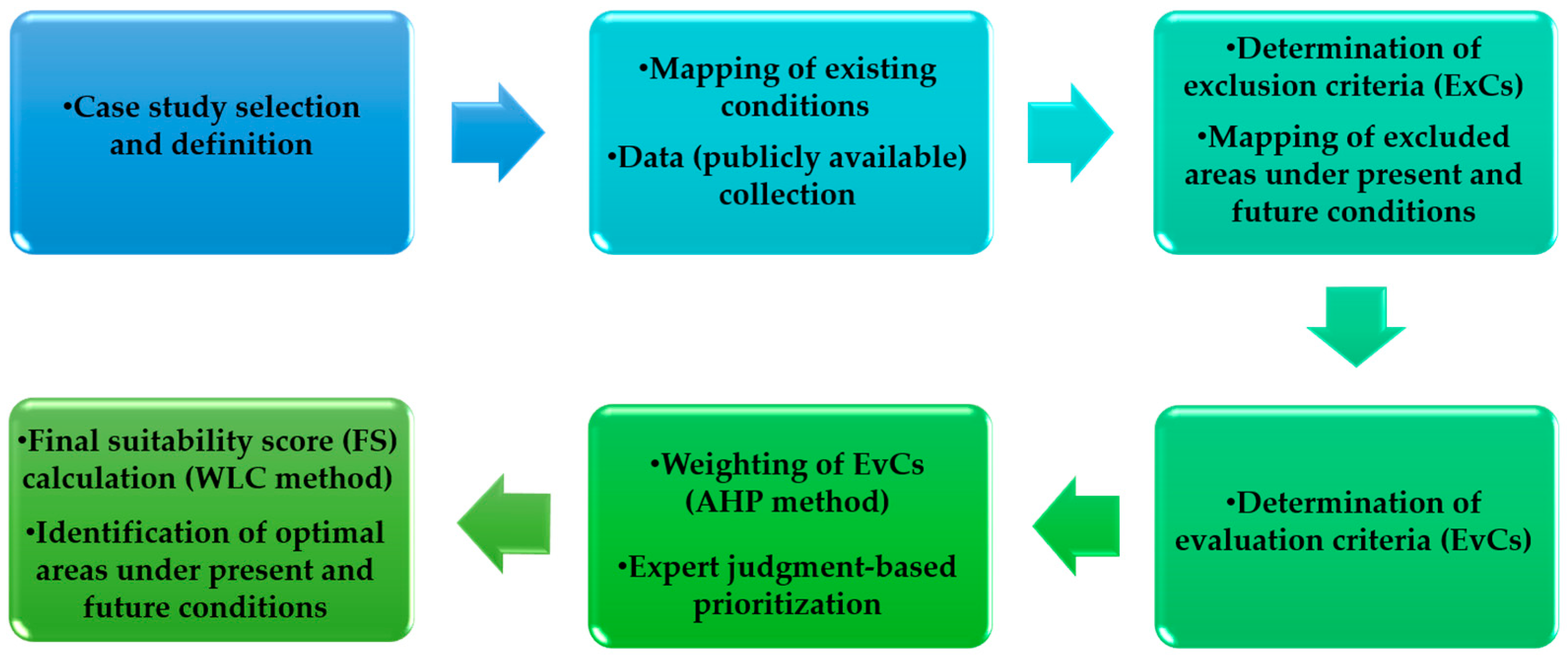
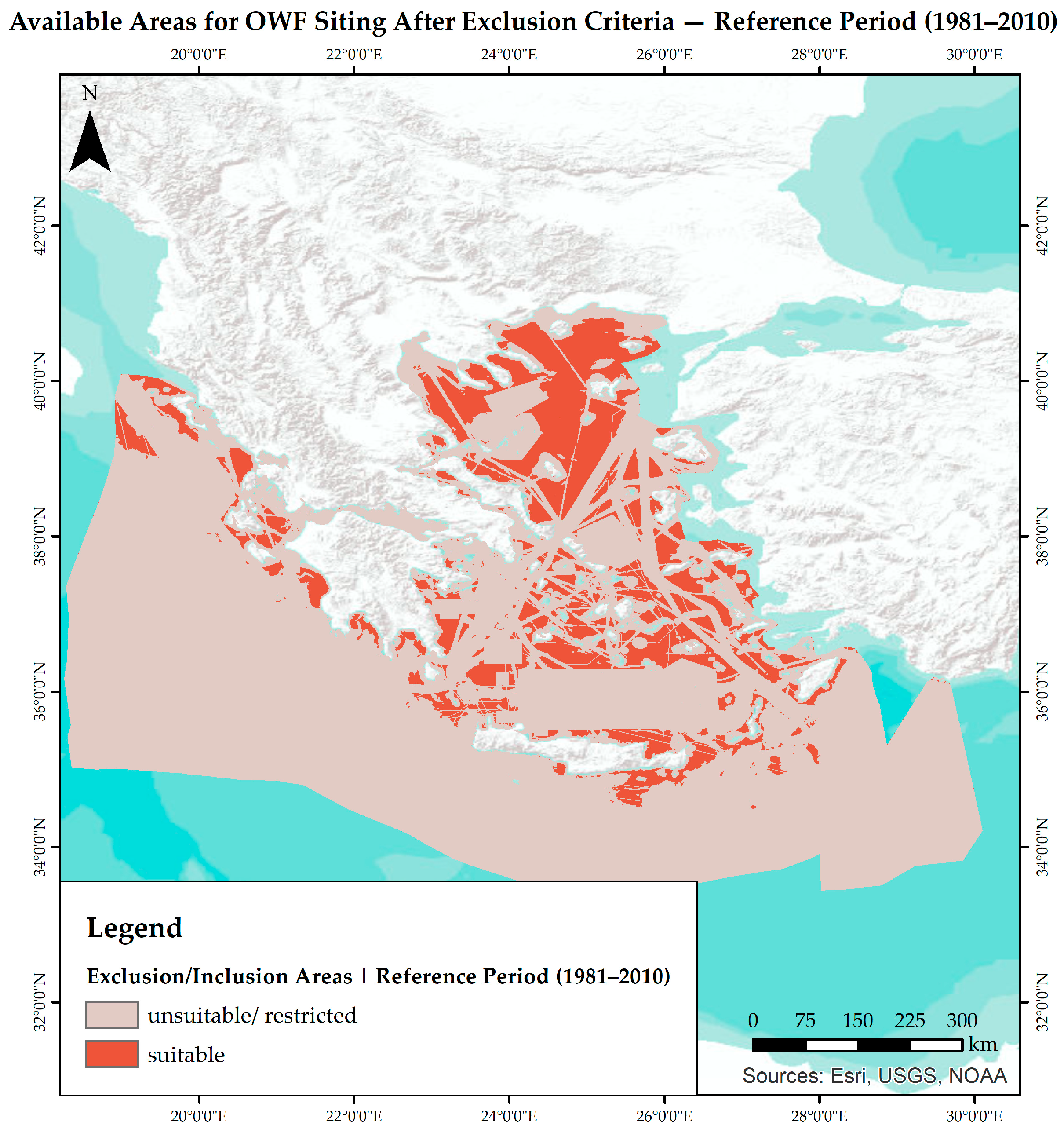

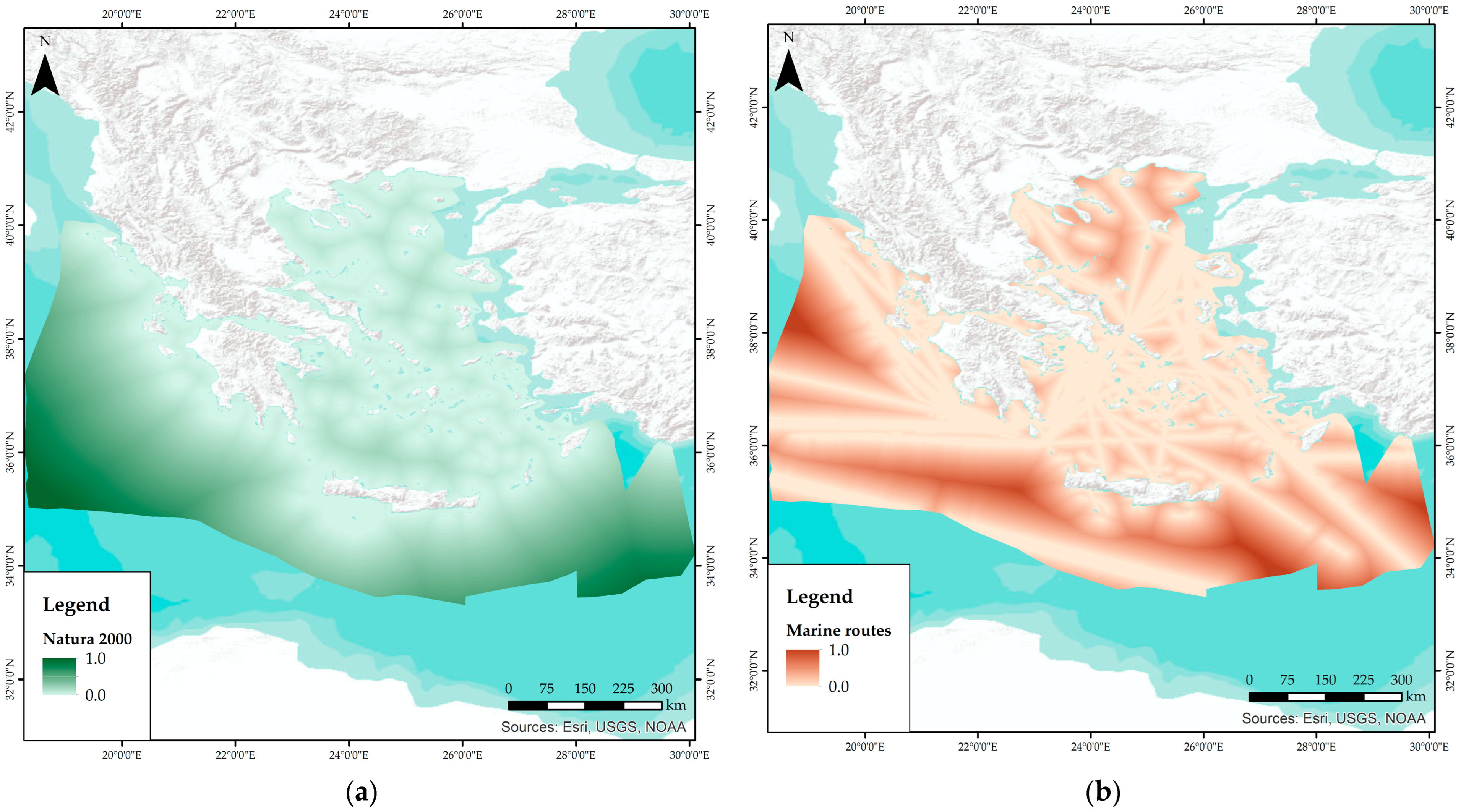
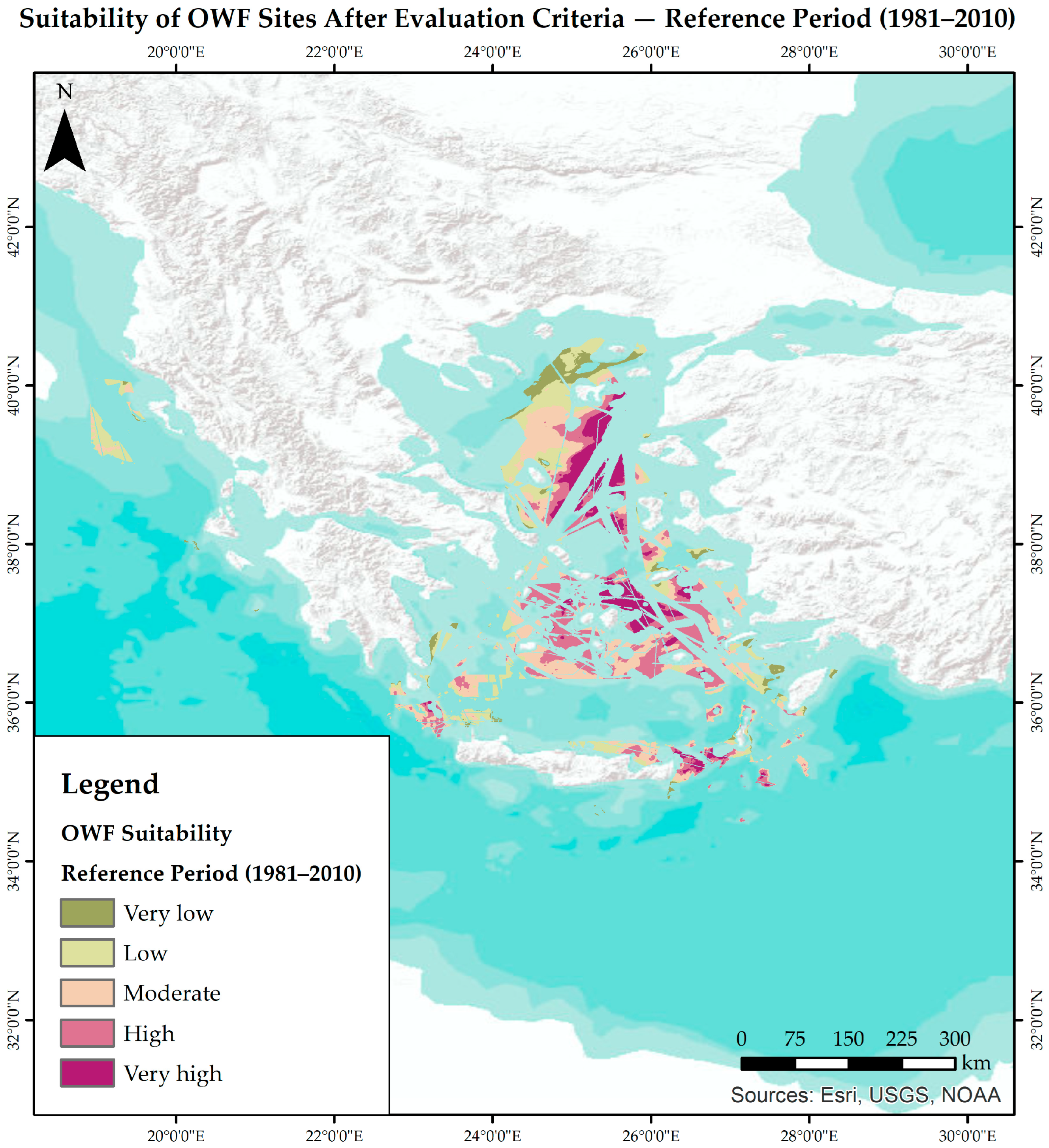
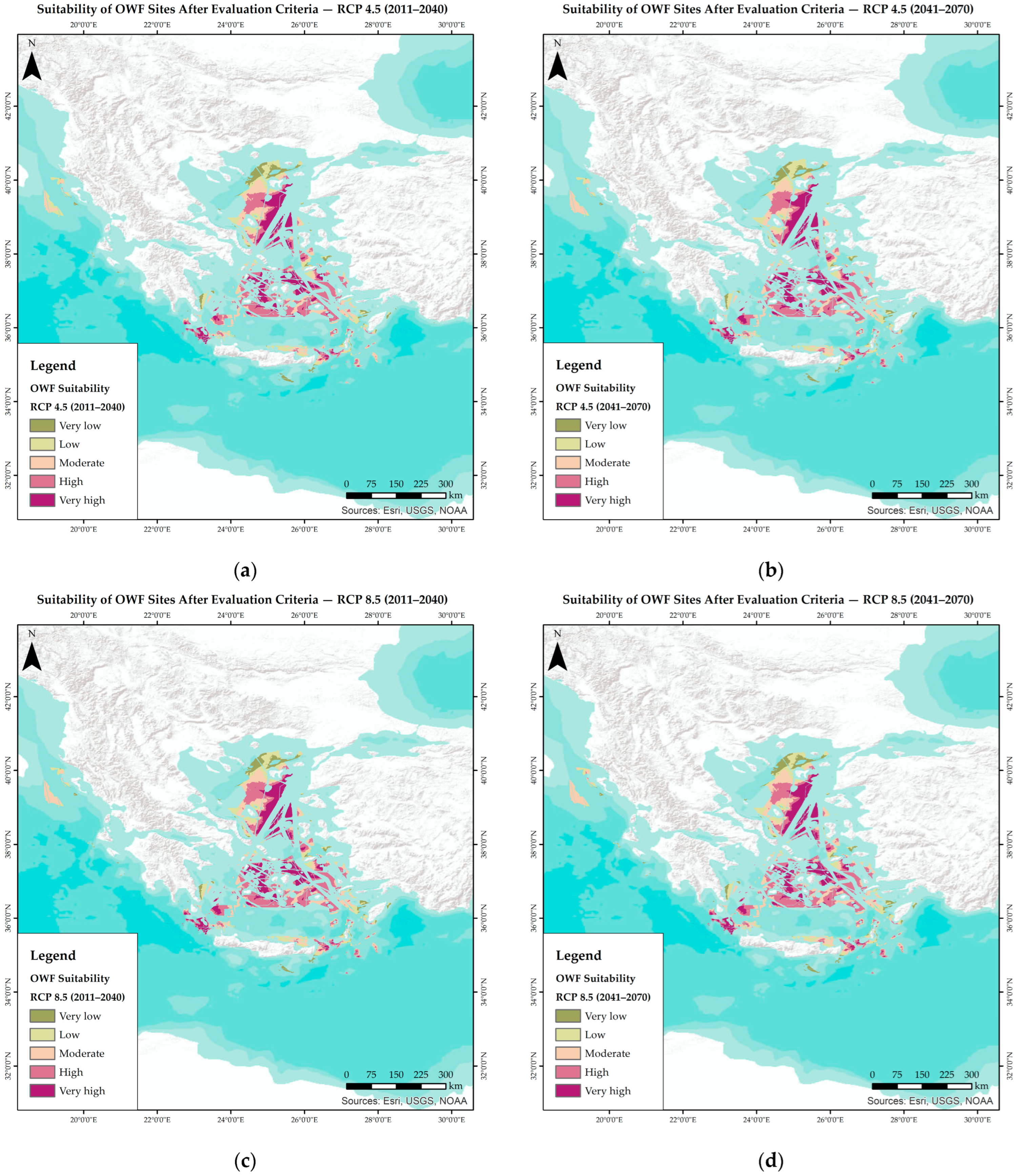
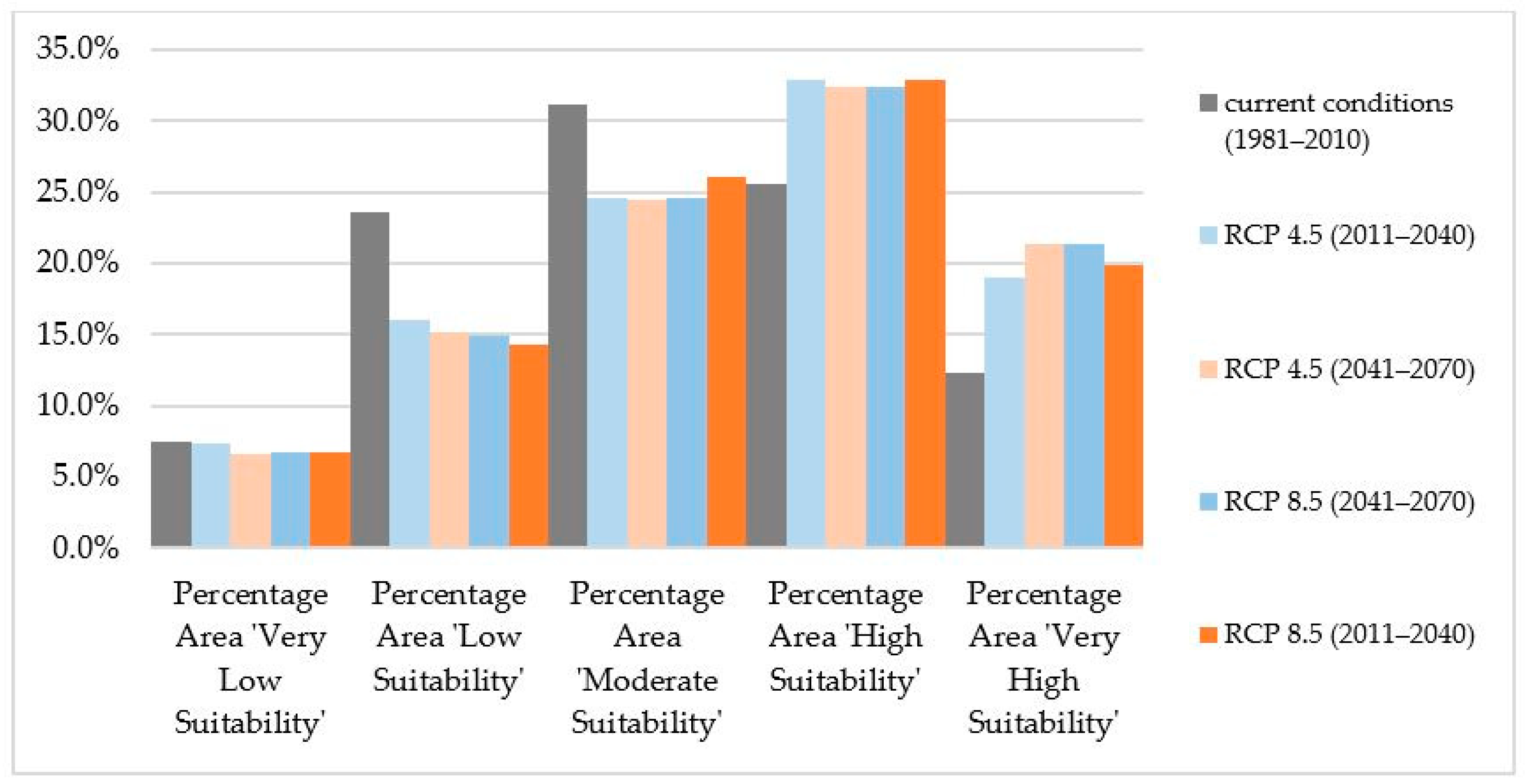
| No. | Criterion | Exclusion Zone | Buffer Zone | Source |
|---|---|---|---|---|
| EC1 | Water depth | <50 m and >1000 m | - | https://emodnet.ec.europa.eu/en (accessed on 15 March 2025) https://climate.copernicus.eu/ (accessed on 10 February 2025) |
| EC2 | Average wind velocity | <6 m/s | - | https://climate.copernicus.eu/ (accessed on 10 February 2025) |
| EC3 | Environmentally protected areas (EPAs)-Natura 2000 | All | 1000 m | http://geodata.gov.gr (accessed on 15 March 2025) |
| EC4 | EPAs-areas of outstanding natural beauty (AONB) | All | 1000 m | https://filotis.itia.ntua.gr (accessed on 15 March 2025) |
| EC5 | EPAs-important areas for birds | All | 3000 m | https://ornithologiki.gr/en/ (accessed on 15 March 2025) |
| EC6 | EPAs–seagrass meadows | All | 1000 m | Topouzelis et al., 2017 [40] |
| EC7 | Areas of cultural heritage (CHAs)-underwater antiquities | All | 1000 m | https://thalchor-2.ypen.gov.gr (accessed on 15 March 2025) |
| EC8 | CHAs–monuments | All | 3000 m | https://thalchor-2.ypen.gov.gr (accessed on 15 March 2025) |
| EC9 | CHAs-archeological and historical sites | All | 500 m | https://thalchor-2.ypen.gov.gr (accessed on 15 March 2025) |
| EC10 | CHAs–traditional settlements | All | 1500 m | https://thalchor-2.ypen.gov.gr (accessed on 15 March 2025) |
| EC11 | Human settlements | All | 1000 m | http://geodata.gov.gr (accessed on 15 March 2025) |
| EC12 | Bathing coasts | All | 1500 m | http://geodata.gov.gr (accessed on 15 March 2025) |
| EC13 | Areas of military exercise | All | - | https://emodnet.ec.europa.eu/en(accessed on 15 March 2025) |
| EC14 | Marine routes | All | 500 m | https://emodnet.ec.europa.eu/en (accessed on 15 March 2025) |
| EC15 | Fisheries areas | All | 500 m | https://emodnet.ec.europa.eu/en(accessed on 20 March 2025) |
| EC16 | Areas of aquaculture | All | 500 m | https://ypen.gov.gr (accessed on 20 March 2025) |
| EC17 | Airports | All | 3000 m | http://geodata.gov.gr (accessed on 20 March 2025) |
| EC18 | Underwater cables (UC)–telecommunication | All | 500 m | https://thalchor-2.ypen.gov.gr (accessed on 20 March 2025) https://www.submarinecablemap.com (accessed on 22 March 2025) |
| EC19 | UC-energy | All | 500 m | https://www.admie.gr (accessed on 22 March 2025) |
| No. | Category | Criterion | Target |
|---|---|---|---|
| EvC1 | Technoeconomic criteria | Water depth | Min |
| EvC2 | Technoeconomic criteria | Average wind velocity | Max |
| EvC3 | Environmental criteria | Environmentally protected areas (EPAs)–Natura 2000 | Max |
| EvC4 | Environmental criteria | EPAs–areas of outstanding natural beauty (AONB) | Max |
| EvC5 | Environmental criteria | EPAs–important areas for birds | Max |
| EvC6 | Environmental criteria | EPAs–seagrass meadows | Max |
| EvC7 | Safety criteria | Marine routes | Max |
| EvC8 | Safety criteria | Airports | Max |
| EvC9 | Technoeconomic criteria | Ports | Min |
| EvC10 | Technoeconomic criteria | UC–energy | Min |
| Intensity | Definition | Explanation |
|---|---|---|
| 1 | Equal importance | Two criteria contribute equally to the objective |
| 3 | Moderate importance of one over another | Judgment slightly favors one criterion over another |
| 5 | Essential or strong importance | Judgment strongly favors one criterion over another |
| 7 | Very strong importance | Judgment very strongly favors one criterion over another and its dominance is demonstrated in practice |
| 9 | Extreme importance | The highest level of justified dominance of one criterion over another |
| 2,4,6,8 | Intermediate values | Compromises between the adjacent intensities |
| n | 1 | 2 | 3 | 4 | 5 | 6 | 7 | 8 | 9 | 10 |
|---|---|---|---|---|---|---|---|---|---|---|
| Random consistency index | 0 | 0 | 0.58 | 0.90 | 1.12 | 1.24 | 1.32 | 1.41 | 1.45 | 1.49 |
| Criterion | Relative Importance |
|---|---|
| Water depth | 15.02% |
| Average wind velocity | 23.20% |
| Environmentally protected areas (EPAs)-Natura 2000 | 11.71% |
| EPAs-areas of outstanding natural beauty (AONB) | 9.19% |
| EPAs-important areas for birds | 9.04% |
| EPAs–seagrass meadows | 8.24% |
| Marine routes | 4.77% |
| Airports | 3.32% |
| Ports | 6.90% |
| UC-energy | 8.62% |
Disclaimer/Publisher’s Note: The statements, opinions and data contained in all publications are solely those of the individual author(s) and contributor(s) and not of MDPI and/or the editor(s). MDPI and/or the editor(s) disclaim responsibility for any injury to people or property resulting from any ideas, methods, instructions or products referred to in the content. |
© 2025 by the authors. Licensee MDPI, Basel, Switzerland. This article is an open access article distributed under the terms and conditions of the Creative Commons Attribution (CC BY) license (https://creativecommons.org/licenses/by/4.0/).
Share and Cite
Chalastani, V.I.; Feloni, E.; Duarte, C.M.; Tsoukala, V.K. Identifying Sustainable Offshore Wind Farm Sites in Greece Under Climate Change. J. Mar. Sci. Eng. 2025, 13, 1508. https://doi.org/10.3390/jmse13081508
Chalastani VI, Feloni E, Duarte CM, Tsoukala VK. Identifying Sustainable Offshore Wind Farm Sites in Greece Under Climate Change. Journal of Marine Science and Engineering. 2025; 13(8):1508. https://doi.org/10.3390/jmse13081508
Chicago/Turabian StyleChalastani, Vasiliki I., Elissavet Feloni, Carlos M. Duarte, and Vasiliki K. Tsoukala. 2025. "Identifying Sustainable Offshore Wind Farm Sites in Greece Under Climate Change" Journal of Marine Science and Engineering 13, no. 8: 1508. https://doi.org/10.3390/jmse13081508
APA StyleChalastani, V. I., Feloni, E., Duarte, C. M., & Tsoukala, V. K. (2025). Identifying Sustainable Offshore Wind Farm Sites in Greece Under Climate Change. Journal of Marine Science and Engineering, 13(8), 1508. https://doi.org/10.3390/jmse13081508








